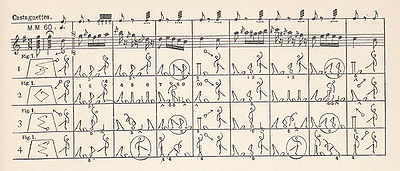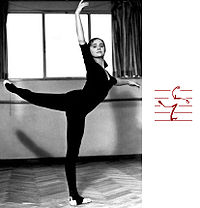- Dance notation
-
Dance notation is the symbolic representation of dance movement. It is analogous to movement notation but can be limited to representing human movement and specific forms of dance such as Tap dance. Various methods have been used to visually represent dance movements including:
- Abstract symbols
- Figurative representation
- Track or path mapping
- Numerical systems
- Music notation
- Graphic notation
- Letter and word notations
Contents
Usage
The primary use of dance notation is the preservation of classic dance documentation, analysis and reconstruction of choreography and dance forms or technical exercises. Many different forms of dance notation have been created but the two main systems used in Western culture are Labanotation (also known as Kinetography Laban) and Benesh Movement Notation. Eshkol-Wachman Movement Notation and DanceWriting are also in use, but to a lesser extent.
Another purpose of dance notation is the documentation and analysis of dance in dance ethnology. Here the notation is not used to plan a new choreography but to document an existing dance. Dance notation systems developed for the description of European dance are often not applicable and not appropriate for the description of dances from other cultures, e.g. the polycentric dances of many African cultures, where the movement of the body through space is less important and a great deal of the movements takes place inside the body. Attempts have been made by ethnomusicologists and dance ethnologists to develop specific notation systems for such purposes.
History
The first computerized notation system, which displayed an animated figure on the screen which performed the dance moves specified by the choreographer, was the DOM dance notation system, created by Eddie Dombrower on the Apple II personal computer in 1982. (See Dance Notation Journal, Fall, 1986, 4(2) pp. 47-48.) Several notation systems are used only for specific dance forms, for example, Shorthand Dance Notation (dances from Israel), Morris Dance Notation (Morris dance), and Beauchamp-Feuillet notation (Baroque dance).
Ann Hutchinson-Guest's seminal book Choreographics (1989), compares thirteen historical and present-day dance notation systems (with visual examples) and through 'one to one' comparisons illustrates the advantages, and disadvantages of each system. The book is good introduction to the development and implementation dance notation systems.
In 1975 Ann Hutchinson-Guest reconstructed the choreographer Arthur Saint-Léon's Pas de Six from his 1844 ballet La Vivandière along with its original music by the composer Cesare Pugni, for the Joffrey Ballet. The piece was reconstructed from Saint-Léon's own method of dance notation known as La Sténochorégraphie. In 1978 Pierre Lacotte staged the Pas de Six for the Kirov/Mariinsky Ballet, who still retain it in their repertory. The Pas de Six has since been staged by many ballet companies all over the world, and is known as either the La Vivandière Pas de Six or the Markitenka Pas de Six (as it is known in Russia).
One of the most famous collections of dance notation is the Sergeyev Collection, which was recorded in the method of notation devised by Vladimir Ivanovich Stepanov. The collection documents the famous Imperial Ballet's (today the Kirov/Mariinsky Ballet) repertory from the turn of the 20th century - the majority of which were staged by the great choreographer Marius Petipa. The collection includes Petipa's original choreographic designs for such ballets as The Sleeping Beauty, Giselle, Le Corsaire, Swan Lake (staged with Lev Ivanov). Other works included are the original version of The Nutcracker, and the Imperial Ballet's definitive Coppélia. It was with these notations that many of these works were first staged outside of Russia, forming the nucleus of the Classical Ballet repertory.
Notation and computers
There are four areas of dance notation research and development:
- notation editing software for the creation of printed notation scores
- machine-readable versions of existing dance notation
- handwritten and / or machine readable dance notation for computer animation and Human use
- machine specific movement notation such as Motion capture data
See also
See also Category: Dance notation.See also Category: Dance notators.- Labanotation
- Sergeyev Collection
- Stepanov Choreographic Notation
- Motif Description (a subset of Labanotation)
- Benesh Movement Notation also known as "Choreology"
- DanceWriting
- Eshkol-Wachman Movement Notation
- Action stroke dance notation
- Beauchamp-Feuillet notation
- Dance score
Further reading
- Cage, J. and Knowles, A. (1973) Notations. Reprint Services Corp. ISBN 0-685-14864-5
- Drewes, Henner (2003) Transformationen - Bewegung in Notation und digitaler Verarbeitung in Fellsches, J (Ed) Folkwang-Texte Bd. 18. Verlag Die Blaue Eule, Essen. ISBN 3-89924-057-X
- Hutchinson Guest, A. (1989) Choreographics: a comparison of dance notation systems from the fifteenth century to the present. Routledge ISBN 90-5700-003-2
- Neagle, R.J. and Ng, K.C. (2003) Machine-representation and visualisation of a dance notation in Proceedings of electronic imaging and the visual arts - London July 2003
Dance Types Solo · Partner · Group
Ceremonial · Competitive · Concert · Participation · SocialGenres Acro · Bachata · Ballet · Ballroom · Baroque · Belly · Bhangra · Bharatanatyam · Breaking · Chicago Style Stepping · Country-western · Cumbia · Disco · Erotic · Folk · Forró · Hip-hop · Jazz · Kabuki · Kathak · Kathakali · Krumping · Kuchipudi · Lap · Line · Manipuri · Merengue · Modern · Mohiniyattam · Odissi · Persian · Salsa · Sattriya · Scottish Highland · Sequence · Street · Swing · Tango · Tap · Waltz · War
Technique Choreography · Connection · Dance theory · Lead and follow · Moves (glossary) · Musicality · Spotting · Turnout
See also Costumes · Etiquette · History · List of dances · Music · Notation · Outline · Research · Science
Dance and health · Dance in film · Dance in mythology and religionCategories:
Wikimedia Foundation. 2010.


